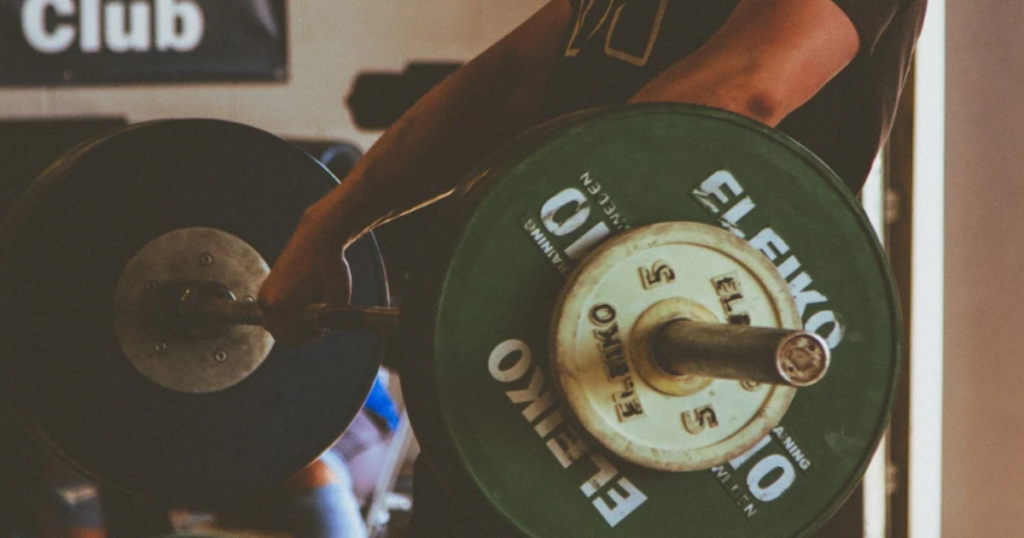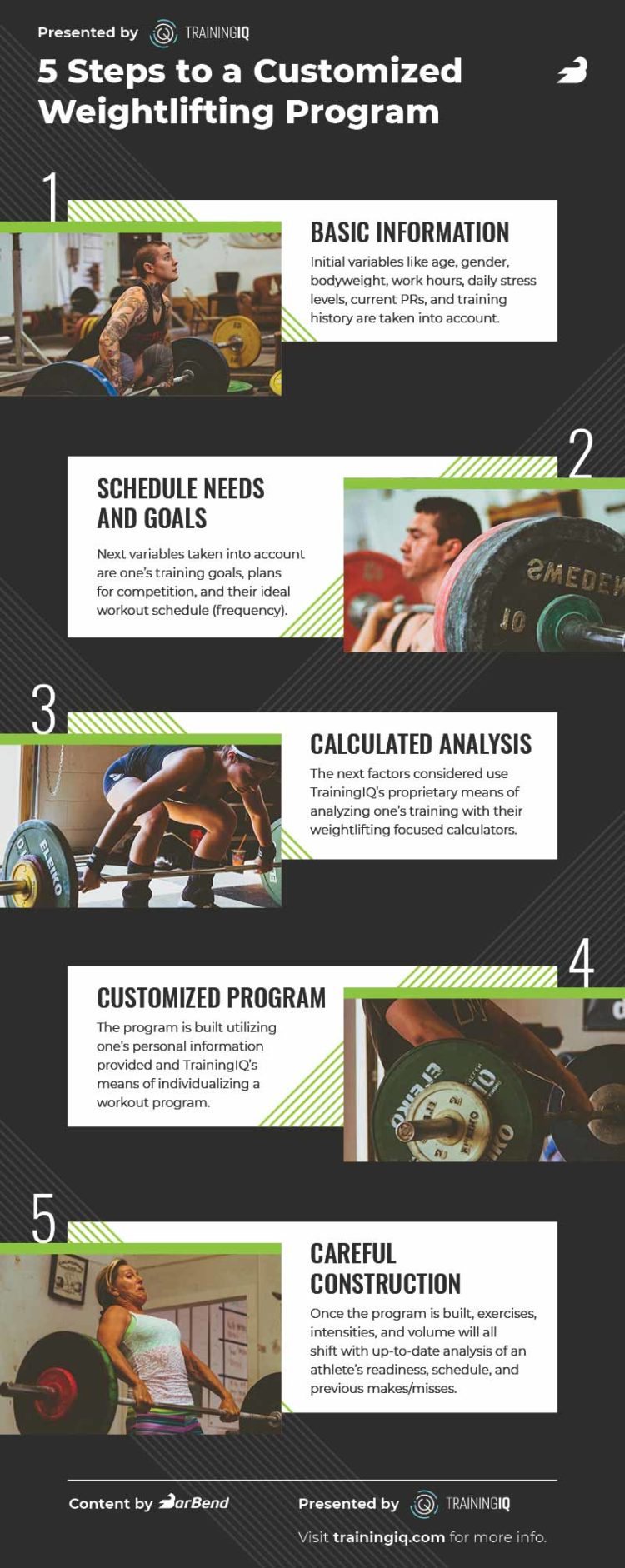If you’re already a weightlifter, then you’re probably well aware of how long it takes to really dial in proper form for the snatch and clean & jerk. It can take years to fully understand the Olympic lifts, and even then, weightlifters still practice their trade day-in and day-out.
There are multiple variables in weightlifting needed to progress in the sport in a safe and smart manner. To be successful in the sport, an athlete needs multiple training variables to align, and programming is perhaps the most important.
But what factors make up the best weightlifting programs? And how do athletes — and coaches — know they’re on the right track?
Keys to the Perfect Weightlifting Program
What makes a great weightlifting program? Every athlete will have their own set of weaknesses, strengths, and gaps in knowledge based off of their previous training experience. Sean Waxman, Head of Programming at TrainingIQ, explains that multiple training variables need to be accounted for when designing training programs: Customization, Sustainability, and Careful Construction.
Waxman has been involved in the sport of weightlifting for over 25 years. Throughout his time as a coach, he’s helped multiple athletes reach podium positions at the international and national level, and has coached athletes to break American Weightlifting records. TrainingIQ leans on Waxman’s experience to develop intuitive programs for every level of athlete.
Great coaches and programs can tie an athlete’s past to their present to create a comprehensive workout program. TrainingIQ, for example, focuses on three major keys when building workout programs, then treats every athlete as a unique case.

1. Customization
Whether you’re a beginner, intermediate, or expert athlete, the concept of customization in a program is paramount to both short and long-term training progress.
Important Training Variables
TrainingIQ customizes workout programs by looking at multiple variables that extend outside of the gym and include things like:
- Age
- Training History
- Work Hours
- Gender
- Stress Levels
- Bodyweight
- Daily Stresses
- Competition Plans, training focus and frequency, and workout schedule
Waxman explains these are only a few of the outside variables that may not seem directly related to training, but play a heavy role in how an athlete will feel on a daily basis. Then to take it a step further, TrainingIQ looks at training ratios that can suggest where weaknesses and strengths are present.
- Snatch to clean & jerk ratio
- Back squat to front squat ratio
- Balance of strength vs. technique
The lifting ratios used by Waxman and TrainingIQ help with the fine-tuning of exercise selection, modification of intensity, and fluctuations in volume based off an athlete’s training state or competition timeline. Below, we’ve explained more in-depth how TrainingIQ uses these systems to build the best program to match an athlete’s needs.
Snatch to Clean & Jerk Ratio
This ratio identifies the optimal maximal percentages an athlete should be striving for when training their snatch and clean & jerk. If an athlete has a lagging snatch, then this ratio will suggest additional snatch-related work. Additionally, if an athlete has a weak clean & jerk compared to the snatch, then their program will be adjusted accordingly to offer more volume and exposure to this “lagging” lift.
Back Squat to Front Squat Ratio
Similar to the snatch to clean & jerk ratio, there exists an ideal target ratio between an athlete’s back squat and front squat. If an athlete’s back squat or front squat is lagging, then the athlete will be exposed to more volume and a mix of lifts to facilitate the growth of the lagging squat. Since the clean & jerk is closely related to the front squat, and the back squat is relatable to one’s overall strength, understanding this squat ratio can be useful for progressing a lifter’s foundational strength.
Balance of Strength Vs. Technique
The balance of strength versus technique is another highly important variable when creating programs. This requires a mix of ratio analysis and tracking of the athlete’s weekly makes and misses to assess where an athlete is potentially falling behind the most.
Waxman notes that weightlifting is a high precision sport, and there needs to careful attention spent on precision and speed compared to simply grinding out maximal lifts. When programming workouts for TrainingIQ, he points out that they carefully construct how an athlete progresses in their program based off the athlete’s lift ratios and what the athlete is logging (makes & misses). These two factors (among other variables) will help dictate the flow of the athlete’s periodized weightlifting program.
He further explains that identifying weaknesses in one’s training is an area that TrainingIQ spends a lot of time on when customizing a workout program. This also helps athletes from falling into the trap of only practicing lifts that they prefer and favor, not necessarily the lifts that they need.
2. Sustainability
The next key to the perfect weightlifting workout program is sustainability. New programs and exercises can be fun, but fun is only part of what makes a successful athlete and lifter. Without continual and consistent work and effort put into the gym, then success will be limited.
In strength sports, turnover rate can be pretty high when it comes to athletes working with different coaches and trying different programs. This is where the term “program hopping” stems from. Program hopping can be one of the biggest factors that can deter progress, and that’s for every level of athlete: Beginner, intermediate, and advanced.
- Beginner: For beginners, program hopping can create a gap in foundational strength, technique, and knowledge. This can negatively impact the athlete for the rest of an athlete’s career.
- Intermediate: The intermediate athlete will most likely need attention on a variety of foundational strengths and fine tuning of the competition lifts. Program hopping at this level can create bad habits and weaknesses in competition lifts due to inconsistent tracking.
- Advanced: The advanced athlete will more than likely be at a point in their career where they need fine tuning on their competition lifts and address identifiable weaknesses.
Sustainability for Weightlifting Athletes
So what does sustainability mean for weightlifting athletes specifically? The program must be challenging enough to keep an athlete interested and improving, but not so extreme that an athlete has trouble sticking with it.
If an athlete is frequently hopping from program to program, or coach to coach, then gaps could form between where an athletes needs to spend most of their attention in training, their current progress, and long-term success.
Athlete burnout can occur in multiple scenarios, and that’s why TrainingIQ advocates moderation. For example, when a workout program has no deviation in intensity or volume, burnout can occur. Burnout can also occur in workout programs that are varied, but where intensity and volume are regularly too high or too low.
A sustainable weightlifting workout program will entail a thoughtfully periodized workout structure. In Training IQ’s case, they provide programmed workouts on a weekly basis designed to manifest into long-term success. TrainingIQ takes training a step further by adjusting daily workout volume in relation to an athlete’s makes and misses. In some cases, misses can be a sign of external factors (like stress) impacting an athlete or intensity and volume that is programmed too high.
Sustainability results from balancing an athlete’s daily life stress and their gym performance. As opposed to generating quick but fleeting results, sustainability works to create a healthy long-term relationship between an athlete and their training.
3. Careful Construction
The third key to building successful weightlifting programs could be summarized best as: The Method to the Madness. Every coach and workout program should incorporate tried and true methodologies for developing strength and creating success on the platform.
TrainingIQ develops strength and platform success for their athletes in a few thoughtfully structured ways. First, they create programs that are built on one of the most foundational and sound concepts in strength training: Periodization. Periodization is, at its core, the use and organization of training phases over time. Consider periodization the skeleton of the workout program and the exercises, intensities, and volumes used as the muscles, tendons, and ligaments. Without a strong skeleton creating a strong structure, then none of these will function to their full capacity.

Periodization will create a game plan for things like progressive overload, intensity and volume relationship, and exercise refinement. This concept also helps limit athlete burnout, as it allows both TrainingIQ and their athletes to see and track their progress in the snatch and clean & jerk, which are areas that TrainingIQ specializes in.
The second way TrainingIQ helps athletes develop strength and platform success is by tailoring their programs to an athlete’s availability. As opposed to building programs that require the athlete to adjust their training frequency to fit the program, TrainingIQ instead builds workout programs around an athlete’s stated availability. This can be fundamental for success, as it can lead to better workout consistency, which will help further direct the construction of the athlete’s program.
On top of building programs that fit an athlete’s availability, TrainingIQ also tailors the type of lifts an athlete will perform on a week-to-week basis in a few different ways.
- Heavy focus on deficiencies rather than an athlete’s current strengths.
- Weekly volume, intensity, and exercise refinement based off of things like an athlete’s age, abilities, and stress levels.
- Exercises with direct carry over to the snatch and clean & jerk, as opposed to vanity exercises.
All three of the above factors can influence an athlete’s program by allowing TrainingIQ to assess where an athlete needs the most attention. No one workout will bring success to every athlete, although, by constructing programs based off of multiple factors, TrainingIQ helps athletes work towards their goals by the best means possible.
As an athlete improves and their needs change, TrainingIQ’s program prescription will change as well.
Wrapping Up
Long-term success in the gym and on the platform is dictated by multiple workout variables and the careful construction of the steps needed along the way to keep an athlete healthy.
When enlisting TrainingIQ as your programming platform, athletes receive a “perfect” program that utilizes a proprietary analysis to match your lifestyle, goals, and needs. This is incredibly useful for athletes because this analysis can help highlight an athlete’s biggest weaknesses, which can help construct a program to provide both immediate success in the gym/on the platform, and promote a healthy relationship with long-term training.
